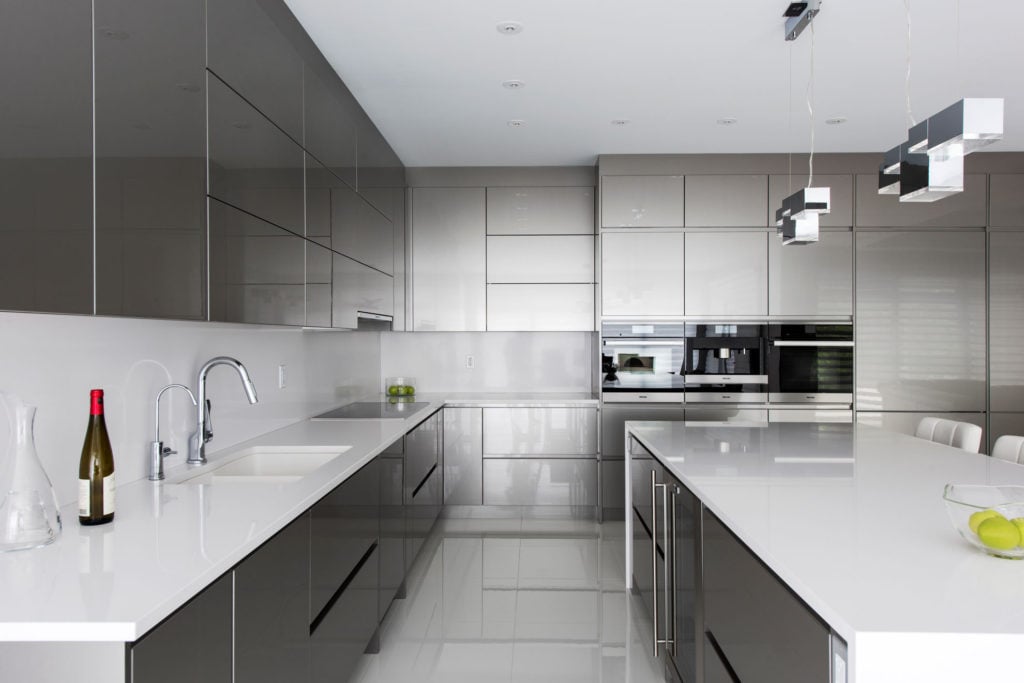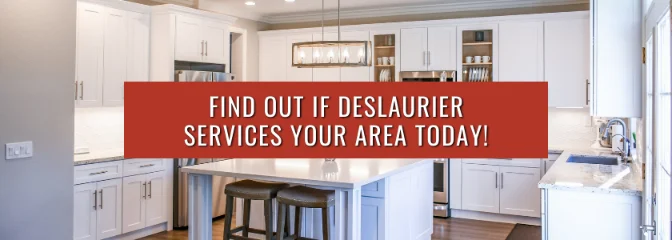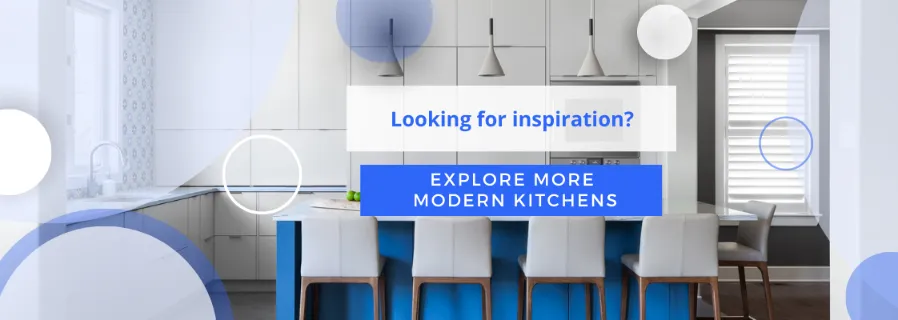31/03/2023 • Blog, Comparisons, Design Tips
Modern vs. Contemporary Kitchen Design: What's The Difference?
Estimated Read Time: 7 Minutes
The kitchen is often considered the heart of the home, where families and friends gather to cook, eat, and socialize.
As the years change, so too does the world of kitchen design; transforming to reflect evolving lifestyles, style preferences, and technological advancements.
Two of the most popular kitchen design styles are modern and contemporary. While they may sound like synonyms of one another – and do share some similarities – they also have distinctive elements that set them apart.
At Deslaurier, we have over 40 years of experience providing our clients with custom cabinets and kitchen design services. In that time, we’ve helped hand-craft hundreds of kitchens to cultivate a modern or contemporary design style.
With so many moving parts between the two, it can be difficult to know where one design style ends and the other begins.
In this article, we'll explore contemporary and modern kitchen designs, comparing their similarities and determining their key differences to help you determine if either style is right for your home.
Let’s get started!
|
Table of Contents |
|
Elements of Modern Kitchen Design |
Modern Kitchen Design
While the terms “modern” and “contemporary” are often used interchangeably, there is a real distinction between the two as design styles.
Modern kitchen design refers to a specific design style that emerged in the early 20th century that was initially characterized by flat surfaces, geometric forms, and little to no ornamentation.
Now, modern kitchen design has become a part of a larger trend emphasizing clean lines, open spaces, and minimalistic design elements that feature highly functional post-industrial materials.
A modern kitchen design will incorporate several of the following characteristics:
- Horizontal Lines
- Frameless or Full Overlay Cabinetry
- Monochromatic Colour Palettes
- Minimalistic Details and Ornamentation
- Simple Hardware
- Industrial Accent Pieces
Driven by simplicity, modern kitchen design maximizes functionality by utilizing space and organized cabinetry.
Modern kitchen design also incorporates the latest technologies and materials. For example, modern kitchens may feature advanced lighting systems, state-of-the-art appliances, and energy-efficient materials.
Modern kitchens are typically designed to be clutter-free, with everything from the appliances to the cabinets arranged in a logical, easy-to-use manner. This makes modern kitchens highly efficient and practical for everyday use.
Contemporary Kitchen Design
Contemporary kitchen design, on the other hand, refers to current and trendy design styles. The word contemporary literally means “current trends, in the now”.
It doesn’t have the same structured characteristics and rules as modern design does; meaning two contemporary kitchen designs could be far more unique from one another than two modern kitchens might be.
In terms of the three most popular kitchen design “styles” – traditional, transitional, and modern – contemporary kitchens would fall somewhere between transitional and modern.
The key benefit of contemporary kitchen design is its flexibility, allowing it to be adapted to suit a variety of tastes and budgets.
While some contemporary kitchens are designed to be ultra-modern and high-tech, others incorporate more traditional elements, such as wood accents or warm lighting.
Where They’re Similar
Modern and contemporary kitchen designs have more in common than just their names.
For starters, they both emphasize practical, open kitchen layouts. Where kitchen design was once about grandiose features and decorative ornamentation, it’s now focused on enhancing the function and efficiency of the space. Something both of these schools of design do in spades.
Large, multi-purpose central islands are a staple in modern and contemporary kitchens. They bring a lot of versatility to a kitchen layout.
Islands afford more overall cabinet storage and can help spread out features in a kitchen. Appliances like dishwashers, microwaves, and even cooktops can be incorporated into kitchen islands. Not to mention countertop overhang for island seating; perfect for meals and entertaining.
Similarly to modern designs, contemporary kitchens also incorporate technology like smart appliances. Both kitchens are often designed to be eco-friendly, using sustainable materials and energy-efficient appliances.
In terms of their appearance, both contemporary and modern kitchens feature sleek and minimalist aesthetics—even if they might differ in their fluidity. Their styles are clean and crisp and typically don’t feature brash ornamentation, although contemporary kitchens will more commonly have slightly accentuated trim and mouldings.
What Sets Them Apart?
While modern and contemporary kitchen designs share many similarities, they also have some key differences that set them apart.
Modern design refers to an actual historical design movement (specifically the early to mid-20th century), and it follows a strict interpretation of elements.
While new-age kitchen materials and technologies are updated, the characteristics of modern design are firm and definitive. In that sense, modern design has a certain rigidity to it. There are tenets and guidelines that need to be followed in order to achieve a modern kitchen design.
Conversely, contemporary kitchen design is always changing. As the decades pass, the connotation of contemporary design transforms as well, keeping with current and popular trends of the day.
After all, the brash ornamentation we now refer to as Traditional kitchen design would once have been considered contemporary!
Contemporary design has the added benefit of mixing elements and features of other styles; pairing current design trends with timeless qualities. While contemporary kitchens often utilize modern design features, they can also borrow from transitional, traditional, or any other style of design!
Another difference between contemporary and modern kitchen designs is their use of materials. While both styles incorporate products made of metal, glass, and stainless steel, contemporary kitchens more commonly feature warmer materials, such as wood and stone.
Modern kitchens, on the other hand, often feature materials that are highly functional and easy to clean, such as man-made cabinet materials like thermofoil and PET, to name a few.
With that, let’s see how both of these kitchen styles can be implemented!
Modern Kitchen Design Features
We’ve talked about the history and principles of modern design, now let’s take a look at several popular features you’re bound to see in a modern kitchen!
One-piece, slab (flat panel) doors are the classic door style for modern kitchen designs. Their flat and frameless aesthetic perfectly meshes with the linear, minimalist sensibilities of modern design.
While you can use sleek and thin cabinet handles, many people choose to go without any cabinet hardware by using recessed bottoms or tip-on and touch latches.
Modern kitchen cabinet designs popularly utilize man-made materials such as thermofoil, PET, acrylic, and metal. For modern kitchens looking to achieve a wood grain cabinet aesthetic, textured melamine is another engineered product perfect for slab door cabinets.
Interested in a modern cabinet style? Read our article on the 5 Best Materials for Modern Cabinets!
As we mentioned earlier, one key factor of modern design (although not a strict rule by any means) is to use a monochromatic colour palette. This is when a kitchen is centred around varying shades of one colour.
In modern kitchens, it’s popularly done with different grey tones.

As you can see, from the cabinets, to the appliances, to the flooring this kitchen utilizes some form of grey.
It’s also a great example of the large tile flooring you’ll find in many modern kitchens. Large tiles are great for smaller kitchens to make the room feel much larger and you can end up only needing 6 or 8 tiles to complete your entire floor!
Further, matching the grout when doing a tile floor – as opposed to going with a lighter or darker shade – lets the grout blend in with the tile to create a seamless look, almost like poured concrete.
Contemporary Kitchen Design Features
As we’ve mentioned, contemporary kitchens aren’t so cut and dry. They borrow a lot of transitional elements with an updated flair to them.
Our “Lichfield” cabinet door is a good example of these combining styles. It’s a 5-piece shaker-style cabinet door – a staple of transitional kitchen design – that utilizes narrow stiles and rails to create a more modern aesthetic.
Other prominent contemporary features include painted cabinets like grey and white, as well as bolder colours such as blues and greens. They also incorporate warm natural wood tones and grain patterns. In fact, combining painted and wood grain cabinets in a two-tone cabinetry design is a staple in contemporary kitchens.
Speaking of wood, hardwood flooring is a staple of the style, with trendy, wider planks offering a more updated aesthetic over thinner hardwood of the past. Contemporary designs have become known for using light, gentle wood species like white oak for cabinets and flooring alike.
In a sense, contemporary design aims to bring warmth back to the kitchen; with bright and open spaces, upper walls accentuated with open storage like floating shelves, and an emphasis on natural wood elements.
Whereas modern kitchens can sometimes feel a bit “cold” and less comforting – they offer more of a design “statement” – contemporary kitchens are welcoming and organic.
What Design Style is Right For You?
In a nutshell, the modern design style follows stricter guidelines whereas the contemporary design style is more fluid and tolerates “rule-breaking”. That means contemporary designs are more dynamic and they can change year after year to follow the newest trend.
If you want a sleek and streamlined ambiance, the clean lines and minimalist sensibilities of modern design are right up your alley.
If you’d rather have more variety and creativity in your kitchen design, opting for a contemporary style might suit you better. It allows you to bring more personality to your space, with added ornamentation and flexibility to the elements you include.
The added benefit of contemporary design is the ability to include your favourite modern-style features while not being restricted to a completely modern kitchen.
Ultimately, choosing a kitchen design will always come down to your lifestyle, style preferences, and budget. Consider these accordingly and you’ll be able to craft the perfect kitchen design to fit your home!
Design with Deslaurier Custom Cabinets
With so much nuance and similarity between the two, it’s no wonder people often confuse modern and contemporary kitchen designs. We hope this article detailed the differences and helped you better understand which style of kitchen design best suits you and your home.
If you’re looking to install the perfect custom cabinets in your dream kitchen, Deslaurier Custom Cabinets has everything you need! With over 40 years of experience in our name, we provide our clients with a fully customized design process with our talented team of designers.
Book a consultation today with a Deslaurier design expert at our Jupiter, Florida Showroom!
Interested in becoming an authorized Deslaurier dealer? Visit our Become a Dealer page to learn more! Live outside the area? Visit our Find a Dealer page to connect with a Deslaurier dealer near you!

